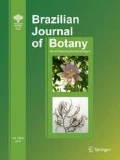Abstract
Wood anatomy of 56 species from 11 genera of Lauraceae collected from Yunnan, China were investigated by light and scanning electron microscopy. Detailed descriptions and comparisons of wood anatomy of different species are given in the paper to help better identification of Lauraceae wood. The qualitative and quantitative data show that wood structures are very similar among the Lauraceae studied. They are almost diffuse-porous, mainly solitary, minority radial, or diagonal multiples. Vessels have simple perforation and scalariform perforation, and the bars of scalariform perforation have bifurcations. The intervessel pits are almost alternate. Wood rays are uniseriate and multiseriate, with the former being relatively rare. All species have axial parenchyma, most of which are vasicentric. The species of Beilschmiedia and Syndiclis marlipoensis also have marginal parenchyma. Oil and mucilage cells are common in axial parenchyma and ray cells. Wood fibers are composed of libriform fibers and fiber tracheids. Many species have abundant septate fibers. Individual differences are found in several species, which may be related to genetic or environmental factors. We have roughly concluded that Beilschmiedia and S. marlipoensis have a close affiliation for they both have simple perforated plates and marginal parenchyma but with no septate fibers. Almost all species of Litsea, Neolitsea, and Actinodaphne obovata have septate fibers, simple and scalariform perforate plate, and scanty paratracheal and vasicentric parenchyma, indicating that they might be sister taxa.





Similar content being viewed by others
References
Bailey IW (1944) The development of vessels in angiosperms and its significance in morphological research. Am J Bot 31:421–442
Bonsen KJM, Kucerea LJ (1990) Vessel occlusion in plants: morphological functional and evolutionary aspects. IAWA Bull 11:292–299
Callado CH, Costa CG (1997) Wood anatomy of some Anaueria and Beilschmiedia species (Lauraceae). IAWA J 18:247–259
Carlquist S (1988) Comparative wood anatomy. Springer, Berlin
Christophel DC, Kerrigan R, Rowett AI (1996) The use of cuticular features in the taxonomy of the Lauraceae. Ann Mo Bot Gard 83:419–432
Dadswell HE, Eckersley AM (1940) The wood anatomy of some Australian Lauraceae with methods for their identification. C.S.I. Res 34:5–48
Gilbert SG (1940) Evolutionary significance of ring porosity in woody angiosperms. Bot Gaz 102:105–120
Heo K, Werff HVD, Tobe H (1998) Embryology and relationships of Lauraceae (Laurales). Biol J Linn Soc 126:295–322
IAWA Committee (1989) IAWA list of microscopic features for hardwood identification. IAWA Bull 10:219–332
Kostermans AJGH (1957) Lauraceae. Commun For Res Inst 57:1–64
Kribs DA (1935) Salient lines of structural specialization in the wood rays of dicotyledons. Bot Gaz 96:547–557
Li J, Li XW (2004) Advances in Lauraceae systematic research on the world scale. Acta Bot Yunnanica 26:1–11
Lin S (1990) Systematic wood anatomy of Lauraceae in Guangdong Province. J South China Agric Univ 11:9–85
Lin JX (1993) Notes on the improvements of wood-sectioning techniques. Chin Bull Bot 10:61–64
Lin Q, Wu ZR, Zhong XM, Yang ZR (2010) Comparative wood anatomy of Illiciaceae in East Asia. Sci Silvae Sin 46:91–100
Metcalfe CR, Chalk L (1950) Anatomy of the dicotyledons, vol 2. Clarendon Press, Oxford, pp 152–173
Nishida S, Van der Werff H (2007) Are cuticular characters useful in solving generic relationships of problematic species of Lauraceae? Taxon 56:1229–1237
Ohtani J, Meylan BA, Butterfield BG (1984) A note on vestures on helical thickenings. IAWA Bull 5:117–131
Parameswaran N, Reinbek WL (1969) On the formation and fine structure of septate wood fibres of Ribes sanguineum. Wood Sci Technol 3:272–286
Raj B, Werff HVD (1988) A contribution to the pollen morphology of neotropical Lauraceae. Ann Mo Bot Gard 75:130–167
Recard SL, Hess RW (1942) American timbers of the family Lauraceae. Trop Woods 69:7–33
Richter HG (1981) Anatomie Des Sekundä Ren Xylems Und Der Rinde Der Lauraceae. Sonderbd Naturwiss Ver Hambg 5:1–148
Richter HG (1987) Lauraceae. Mature secondary xylem. In: Metcalfe CR (ed) Anatomy of the dicotyledons, 2nd edn. vol III. Claredon Press, Oxford, pp 167–171
Rohwer JG (1993) Lauraceae. Springer, Berlin, pp 3–80
Rohwer JG (2000) Toward a phylogenetic classification of the Lauraceae: evidence from matK sequences. Syst Bot 25:60–71
Rohwer JG, Li J, Rudolph B, Schmidt SA, Werff HVD, Li H (2009) Is Persea (Lauraceae) monophyletic? Evidence from nuclear ribosomal ITS sequences. Taxon 58:1153–1167
Shen ZQ (1993) Wood science. China’s Forestry Publishing House, Beijing, pp 27–28
Stern WL (1954) Comparative anatomy of xylem and phylogeny of Lauraceae. Trop Woods 100:1–73
Sun J (2003) Wood anatomy study toward Lauraceae in China. Dissertation, South China Agriculture University
Thomposn WP (1918) Independent evolution of vessels in Gnetales and angiosperms. Bot Gaz 65:83–90
Van der Merwe JJM, Van Wyk AE, Kok PDF (1990) Pollen types in the Lauraceae. Grana 29:185–196
Van Der Werff H, Richter HG (1996) Toward an improved classification of Lauraceae. Ann Mo Bot Gard 83:409–418
Walker JCF, Butterfield BG, Langrish TAG et al (1993) Primary wood processing. principles and practice. Chapman & Hall, London, pp 15–16
Yu CH (1954) The relationship between xylem’s evolution and phylogeny of plants. Acta Bot Sin 3:183–195
Zha FS, He LX, Yang F et al (2008) Spatial patterns of species diversity of Lauraceae plants in Yunnan China. J Chuxiong Univ 23:90–94
Zhao LC, Wang YF, Liu CJ et al (2004) Climatic implications of fruit and seed assemblage from Miocene of Yunnan, southwestern China. Quat Int 117:81–89
Acknowledgments
We would like to thank Professor B.T. Li of South China Agriculture University for helping identify the species. This study was supported by the Nonprofit Industry Research Program of State Quality Inspection Administration of China (2012104006-8) and Key Discipline Construction Funds of Wood Science of Technology (4400-214142).
Author information
Authors and Affiliations
Corresponding author
Rights and permissions
About this article
Cite this article
Sun, J., Wu, J., Wang, X. et al. Comparative wood anatomy of 56 species of Lauraceae from Yunnan, China. Braz. J. Bot 38, 645–656 (2015). https://doi.org/10.1007/s40415-015-0172-8
Received:
Accepted:
Published:
Issue Date:
DOI: https://doi.org/10.1007/s40415-015-0172-8




